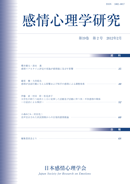巻号一覧

19 巻 (2011)
- 3 号 p. 71-
- 2 号 p. 35-
- 1 号 p. 1-
19 巻, 2 号
選択された号の論文の4件中1~4を表示しています
- |<
- <
- 1
- >
- >|
資料
-
櫻井 優太, 清水 遵原稿種別: 資料
2012 年 19 巻 2 号 p. 35-39
発行日: 2012/02/25
公開日: 2012/05/11
ジャーナル フリーA continuous, real-time, self-rating system of affective states using a joystick has been devised. This study investigated if the process of real-time rating interfered with the participants' affective state. Participants watched a video clip that induced either positive or negative emotions, with or without real-time affect estimation. The emotions that were induced were measured using the word association task (rate of positive words), facial electromyography (integrated activities), electrocardiography (heart rate), and a questionnaire (visual analogue scales). Results indicated that there were no significant differences in induced emotions between the two conditions. It is concluded that using a joystick to assess real-time affect does not interfere with the emotions of the participants.抄録全体を表示PDF形式でダウンロード (699K) -
藤原 健, 大坊 郁夫原稿種別: 資料
2012 年 19 巻 2 号 p. 40-51
発行日: 2012/02/25
公開日: 2012/05/11
ジャーナル フリーThis study examined the influence of affect on conversation behavior and moderated effect of partner's affective state on the influence. Previous studies have focused on how conversation behavior is influenced by one's affective state. This study examined whether the relationships between one's affective state and ranking message (Study 1) or free description (Study 2) would change through the partner's affective state, in addition to previous studies that considered only the main effect of one's affective state. Through the two studies, vignette experiments were conducted and partner's affective state was represented using facial expressions (smile or frowning face) in abstract paintings. In Study 1, 158 undergraduates prioritized four categories of message (edification, disclosure, question, and acknowledgement). These were extracted from Verbal Response Modes (Stiles, 1992) for five contexts composed of five categories including four that were the same as above and another, “non-message”. In Study 2, 42 undergraduates provided free descriptions for the same five contexts. As a result, although there were few significant differences of correlation coefficients between facial expressions in study 1, there were some significant differences in Study 2. These results demonstrated the benefit of considering influences of dyadic combination of affective state on conversation behavior.抄録全体を表示PDF形式でダウンロード (828K) -
─日誌法による検討─伊藤 直, 村田 彩, 松見 淳子原稿種別: 資料
2012 年 19 巻 2 号 p. 52-59
発行日: 2012/02/25
公開日: 2012/05/11
ジャーナル フリーThis study used a diary method and investigated the relationship between self-reports of depressive symptoms, and engagement in “pleasant and unpleasant activities” as well as affective reactions to these activities in Japanese undergraduate students. First, participants (N=121) monitored, for one day, whether they experienced each activity that was included in “the Scale of Life Events in Interpersonal and Achievement Domains for Undergraduate Students” (Takahira, 1998) and rated the degree of affective reactions to each activity. Participants also responded to the Beck Depression Inventory (BDI). Result revealed individual differences in the level of positive and negative affects following experienced activities. Second, based on the BDI scores, we selected depressed (n=34) and nondepressed (n=34) groups of students. Pleasant and unpleasant activities were respectively defined as those activities that individuals rated and followed by positive or negative affect evaluations. Result showed that the depressed group reported significantly less pleasant activities, more unpleasant activities, and a higher level of negative affect following experienced activities. The two groups did not differ significantly in the levels of positive affects. These results demonstrate the importance of conducting an accurate assessment of specific daily activities and associated affects in understanding depression.抄録全体を表示PDF形式でダウンロード (711K) -
小森 めぐみ, 村田 光二原稿種別: 資料
2012 年 19 巻 2 号 p. 60-67
発行日: 2012/02/25
公開日: 2012/05/11
ジャーナル フリーWe investigated whether we could spontaneously (i.e. without effort) infer other person's emotional state from his/her situational information, using the verbal recognition confirmation task. Participants first listened to verbal descriptions of a situation that induced irritation or anxiety, but the descriptions did not include emotional words. Then, participants were shown a series of written descriptions with congruent or incongruent emotional mimetic words. They responded if the descriptions were identical to the ones that they heard. As expected, the situational descriptions that included congruent emotional words were falsely confirmed as identical to the ones that they heard, whereas descriptions with incongruent words were not. However, the same result was observed under the condition of descriptions that included emotional words at the listening phase. Therefore it is suggested that the procedure of the experiment should be improved in order to reject the alternate interpretation.抄録全体を表示PDF形式でダウンロード (814K)
- |<
- <
- 1
- >
- >|